Dear Zazie, Here is today’s Lovers’ Chronicle from Mac Tag dedicated to his muse. Do you have the right words for the right one? Rhett
The Lovers’ Chronicle
Dear Muse,
Pale Love, Pale Rider
a name
in the night
a pleadin’,
in the sleepless mind
always there
since first appearance
come unannounced
stay till want filled
and leave taken
when pleased
at the point
where this is all
that is left,
the only comfort
into the silence,
in this unforgivin’ night
© copyright 2020 mac tag/cowboy coleridge all rights reserved
this change of scenery
should benefit all involved
the verse, the first priority,
could use some fresh air
would be foolin’ myself
and y’all if i said i had
not considered
the greater likelihood
of romantic rendezvous
with this move from a place
that has far more cattle than people
to one of the biggest cities in the South
perhaps appropriate to say
this one is for the future you
© copyright 2019.2024 mac tag/cowboy coleridge all rights reserved
ordinary, does not interest
seekin’ only the high moments
for you, for me
for a losin’ all control,
fallin’ and lettin’ go,
knowin’ you will be caught feelin’
it was that way
please,
please tell me,
it was that way
a fragmentation
did i dream you
do you exist
at times it feels
as if you were here
at other times
it feels as if
you were long ago
© copyright 2018 mac tag/cowboy coleridge all rights reserved
caution…
will talk on and on
about good light
will pull the truck over
to write some verse
will git lost
in daydreams,
in your eyes
the moon comes and goes,
a river on a starry night
look round you
can it be as it was
roam wheresoe’er i may,
by night or day
the things i have seen
i cannot forget
must accept as is
© copyright 2017 mac tag/cowboy Coleridge all rights reserved
Rememberin’…
The blackness paled to gray
A faint shadow
from somethin’ overhead
The face seemed to change
Do not take me back there
© copyright 2016 mac tag/cowboy Coleridge all rights reserved
Did y’all know that
Superman is
impervious
to pressure. Damn
good thing. Oh look
here comes some more
***
Up there; the wind
blows and the view
stretches out for
miles. The silence
permeates all
They lie there mute
against all time
Up there; safety
The wind comforts
Hear the whispers
They listen, they
know there is not
another way
Turnin’, always
turnin’, away
from what matters
From what is right
Darkness descends
Soon to be all
encompassin’
As it must be
So shall it be
I saw the tears
in your eyes and
I wanted to
hold you and make
it go away
I know your pain
I feel your tears
I wish i could
take it away
© copyright 2015 mac tag/cowboy Coleridge all rights reserved
for SKK – the first lyrics i wrote
At first my words were few
And far between
I was holdin’
And foldin’ ’em
Not to be heard
Not to be seen
When my words came
They were too harsh
I was throwin’ ’em
And blowin’ ’em
With no regard
With no respect
Now my words are true
And they are real
I’m shapin’ ’em
And makin’ ’em
Just what I feel
Just for you
© copyright 1998 mac tag all rights reserved
Today is the birthday of Egon Schiele (Tulln an der Donau, Austro-Hungarian Empire; 12 June 1890 – 31 October 1918 Vienna); painter. A protégé of Gustav Klimt, Schiele was a major figurative painter of the early 20th century. His work is noted for its intensity and its raw sexuality, and the many self-portraits the artist produced, including naked self-portraits. The twisted body shapes and the expressive line that characterize Schiele’s paintings and drawings mark the artist as an early exponent of Expressionism.
In 1911, Schiele met the seventeen-year-old Walburga (Wally) Neuzil, who lived with him in Vienna and served as a model for some of his most striking paintings. Very little is known of her, except that she had previously modelled for Gustav Klimt and might have been one of his mistresses. Schiele and Wally went to the small town of Český Krumlov (Krumau) in southern Bohemia. Krumau was the birthplace of Schiele’s mother; today it is the site of a museum dedicated to Schiele. Despite Schiele’s family connections in Krumau, he and his lover were driven out of the town by the residents, who strongly disapproved of their lifestyle, including his alleged employment of the town’s teenage girls as models. In 1914, Schiele glimpsed the sisters Edith and Adéle Harms, who lived with their parents across the street from his studio in the Viennese suburb of Hietzing, 101 Hietzinger Hauptstrasse. In 1915, Schiele chose to marry the more socially acceptable Edith, but had apparently expected to maintain a relationship with Wally. However, when he explained the situation to Wally, she left him immediately and never saw him again. This abandonment led him to paint Death and the Maiden, where Wally’s portrait is based on a previous pairing, but Schiele’s is newly struck. Despite some opposition from the Harms family, Schiele and Edith were married on 17 June 1915, the anniversary of the wedding of Schiele’s parents. In the autumn of 1918, the Spanish flu pandemic that claimed more than 20,000,000 lives in Europe reached Vienna. Edith, who was six months pregnant, succumbed to the disease on 28 October. Schiele died only three days after his wife. He was 28 years old. During the three days between their deaths, Schiele drew a few sketches of Edith.
Gallery
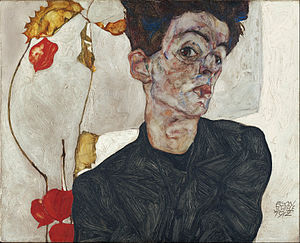
Self portrait
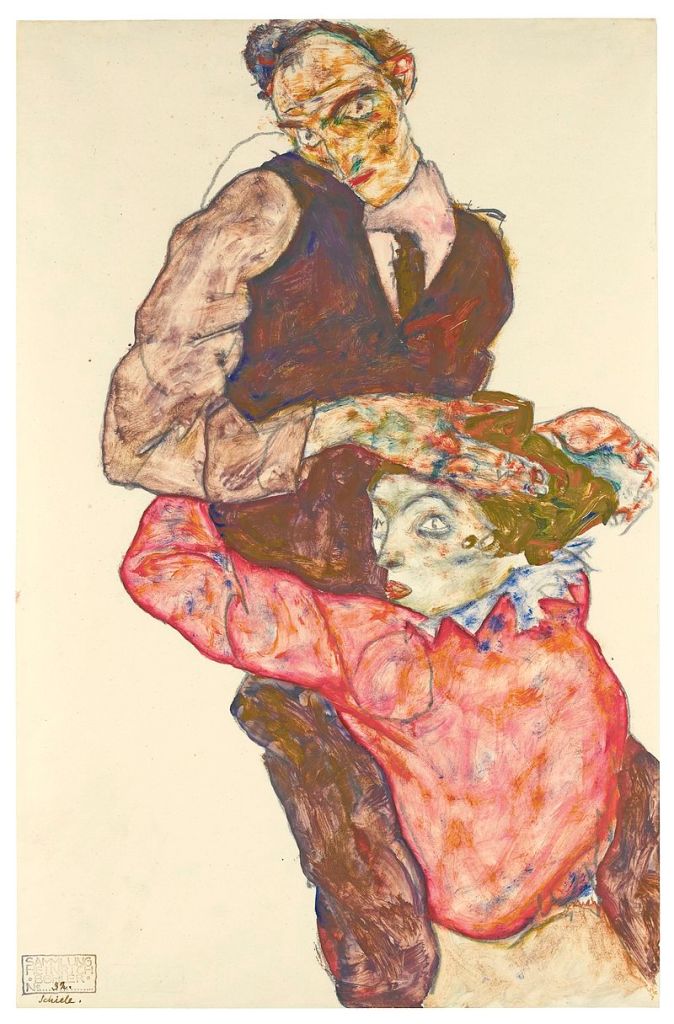
Lovers – Self-Portrait With Wally, c. 1914 – 1915
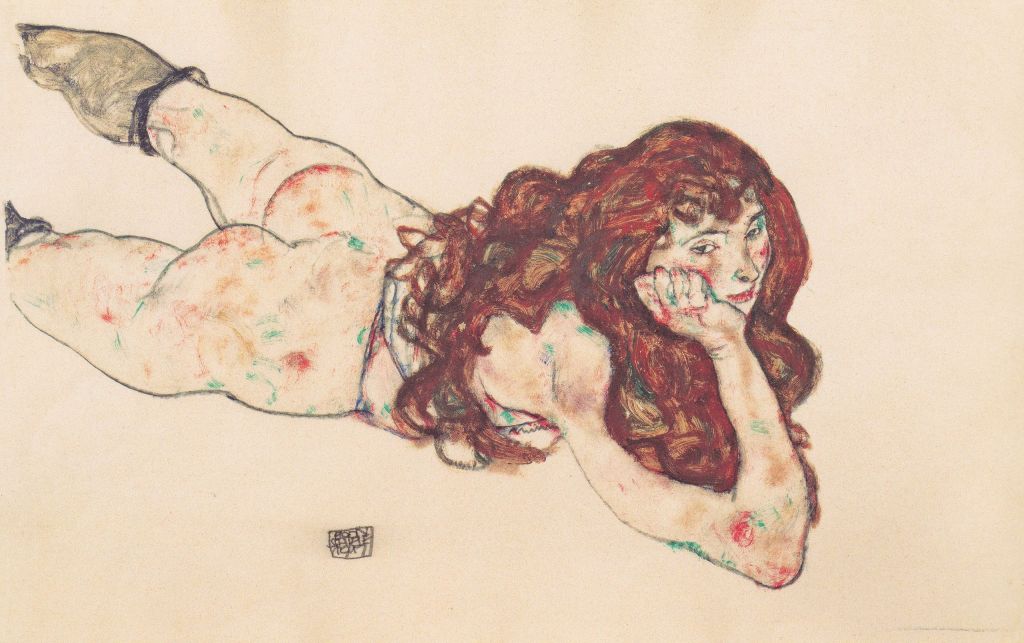
Nude, 1917
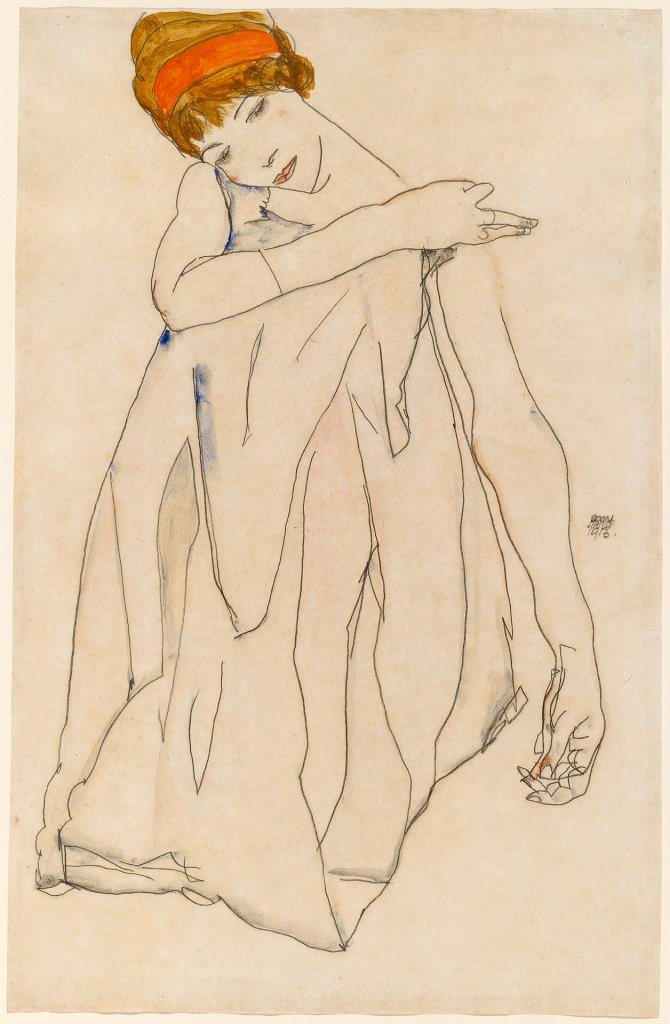
Dancer
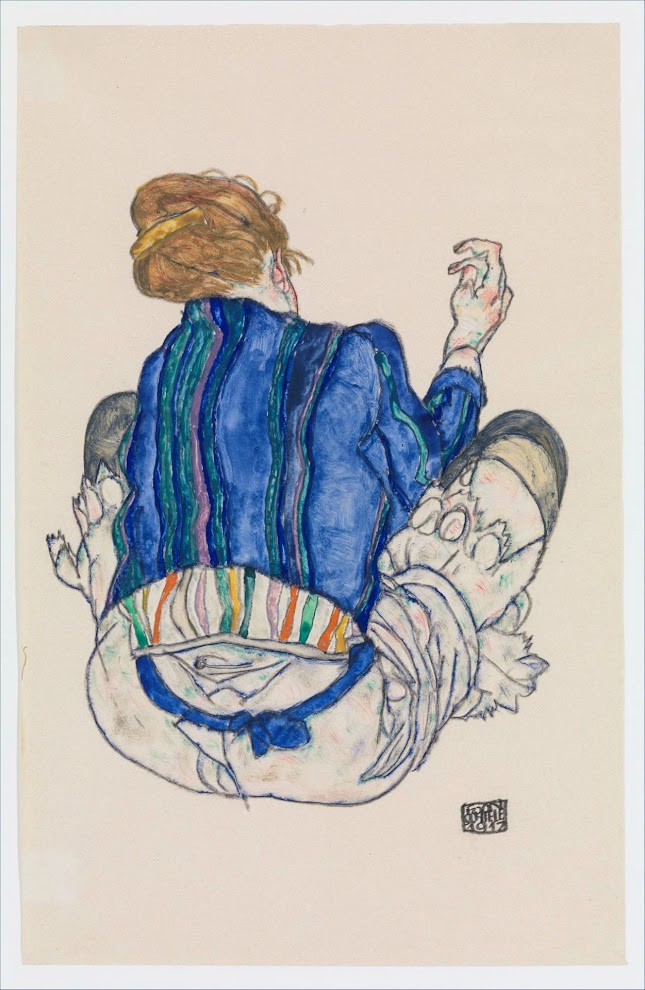
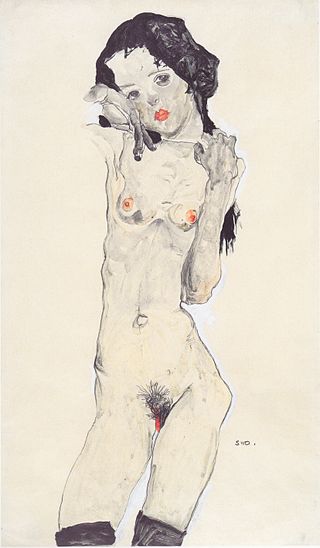
Girl with black hair 1910
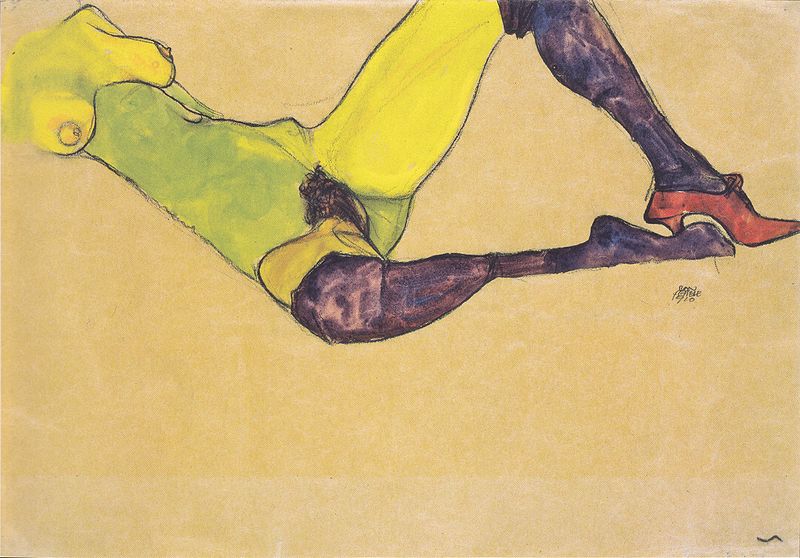
Reclining nude, 1910
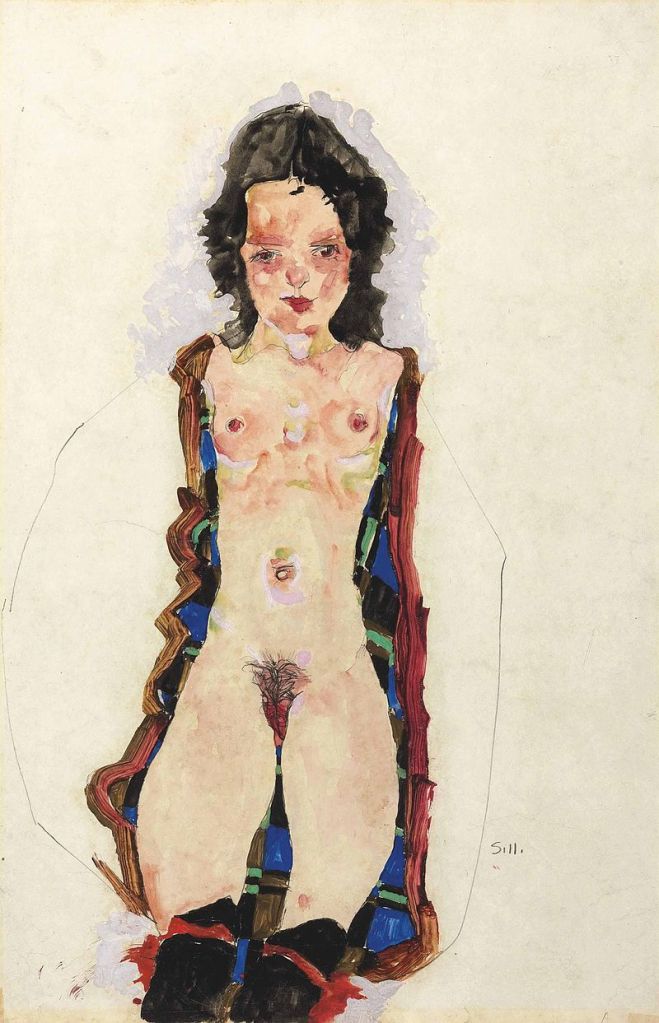
Nude with Red Garters, 1911
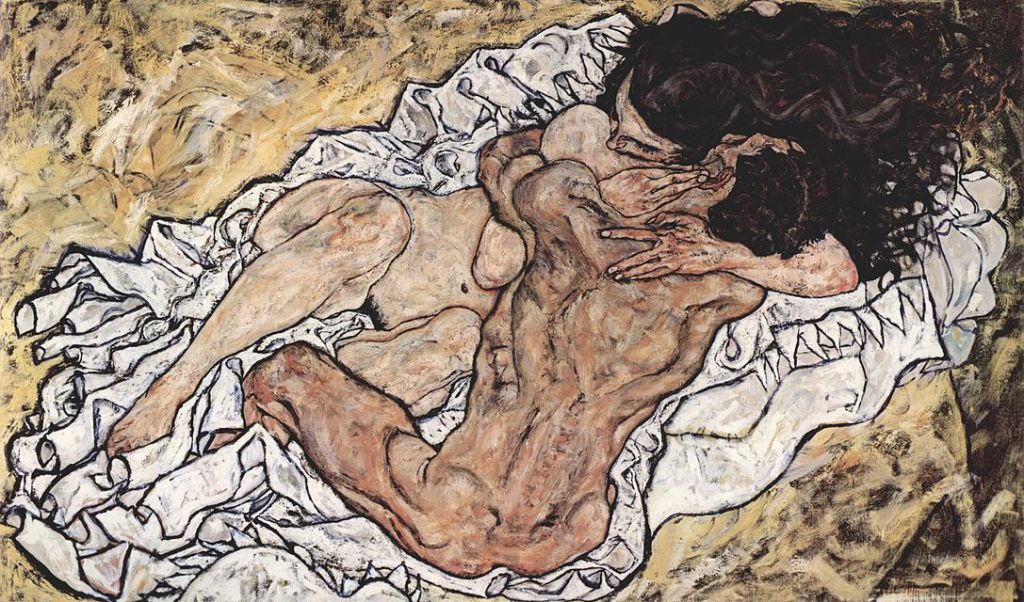
Pair embracing, 1917

Photograph of Schiele, 1914

Schiele’s drawing of his prison cell in Neulengbach

Edith Schiele 1915

Photograph of Schiele, 1910s

Portrait of Anton Peschka 1909

Living room in Neulengbach, 1911

Self portrait

Max Oppenheimer 1910

Portrait of Wally, 1912
 Self portrait, 1910
Self portrait, 1910 Self portrait grimacing, 1910
Self portrait grimacing, 1910 Self portrait with black clay pot, 1911
Self portrait with black clay pot, 1911 Self-portrait with his head down, (1912)
Self-portrait with his head down, (1912) I shall endure for art and for the happiness of my lover. Self-portrait of Schiele in jail, 1912
I shall endure for art and for the happiness of my lover. Self-portrait of Schiele in jail, 1912 Self portrait, 1914
Self portrait, 1914 Self portrait, 1915
Self portrait, 1915 Semi-nude Reclining 1911
Semi-nude Reclining 1911 Valerie Neuzil in black stockings, 1913
Valerie Neuzil in black stockings, 1913 Friendship, 1913
Friendship, 1913 Seated female nude with elbows propped, 1914.
Seated female nude with elbows propped, 1914. Frederike Beer, 1914
Frederike Beer, 1914 Blonde girl in green stockings, 1914
Blonde girl in green stockings, 1914 Green Stockings, 1914
Green Stockings, 1914 Two Women
Two Women Mother with two children II – 1915
Mother with two children II – 1915 Woman (1917).
Woman (1917). Kneeling Girl, Resting on Both Elbows 1917
Kneeling Girl, Resting on Both Elbows 1917 Seated woman with bent knee, 1917
Seated woman with bent knee, 1917 Sitting girl, 1917
Sitting girl, 1917 Nude 1917
Nude 1917 The Family, 1918
The Family, 1918
 Die kleine Stadt II, 1912–1913. View of Krumau an der Moldau
Die kleine Stadt II, 1912–1913. View of Krumau an der Moldau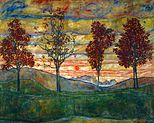 Four trees (Vier Bäume), 1917
Four trees (Vier Bäume), 1917 Stein an der Donau II, 1913
Stein an der Donau II, 1913 The Bridge (Die Brücke), 1913
The Bridge (Die Brücke), 1913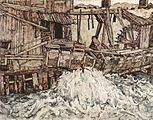 Old Mill (Alte Mühle), 1916
Old Mill (Alte Mühle), 1916 House with Shingles, 1915
House with Shingles, 1915

And today is the birthday of Djuna Barnes (Storm King Mountain, New York; June 12, 1892 – June 18, 1982 Greenwich Village); novelist, poet, playwright, and artist best known for her novel Nightwood (1936), a cult classic of lesbian fiction and an important work of modernist literature.
In 1913, Barnes began her career as a freelance journalist and illustrator for the Brooklyn Daily Eagle. By early 1914, Barnes was a highly sought feature reporter, interviewer, and illustrator whose work appeared in the city’s leading newspapers and periodicals. Later, Barnes’s talent and connections with prominent Greenwich Village bohemians afforded her the opportunity to publish her prose, poems, illustrations, and one-act plays in both avant-garde literary journals and popular magazines, and publish an illustrated volume of poetry, The Book of Repulsive Women (1915).
In 1921, a lucrative commission with McCall’s took Barnes to Paris, where she lived for the next 10 years. In this period she published A Book (1923), a collection of poetry, plays, and short stories, which was later reissued, with the addition of three stories, as A Night Among the Horses (1929), Ladies Almanack (1928), and Ryder (1928).
During the 1930s, Barnes spent time in England, Paris, New York, and North Africa. It was during this restless time that she wrote and published Nightwood. In October 1939, after nearly two decades living mostly in Europe, Barnes returned to New York. She published her last major work, the verse play The Antiphon, in 1958, and she died in her apartment at Patchin Place.
In the 1920s, Paris was the center of modernism in art and literature. She interviewed her fellow expatriate writers and artists for U.S. periodicals and soon became a well-known figure on the local scene; her black cloak and her acerbic wit are remembered in many memoirs of the time. Even before her first novel was published, her literary reputation was already high, largely on the strength of her story “A Night Among the Horses,” which was published in The Little Review and reprinted in her 1923 collection A Book. She was part of the inner circle of the influential salon hostess Natalie Barney, who became a lifelong friend and patron, as well as the central figure in Barnes’s satiric chronicle of Paris lesbian life, Ladies Almanack. The most important relationship of Barnes’s Paris years was with the artist Thelma Wood. Wood was a Kansas native who had come to Paris to become a sculptor, but at Barnes’s suggestion took up silverpoint instead, producing drawings of animals and plants that one critic compared to Henri Rousseau. By the winter of 1922 they had set up housekeeping together in a flat on the Boulevard Saint-Germain. Another close friendship that developed during this time was with the Dada artist Baroness Elsa von Freytag-Loringhoven, with whom Barnes began an intensive correspondence in 1923. ‘’Where Wood gave Barnes a doll as a gift to represent their symbolic love child, the Baroness proposed an erotic marriage whose love-child would be their book.” From Paris, Barnes supported the Baroness in Berlin with money, clothing, and magazines. She also collected the Baroness’s poems and letters.
Quotes
Someday beneath some hard
Capricious star —
Spreading its light a little
Over far,
We’ll know you for the woman
That you are.
- From Fifth Avenue Up
Somewhere beneath her hurried curse,
A corpse lies bounding in a hearse;
And friends and relatives disperse,
And are not stirred.
- From Third Avenue On
- One sees you sitting in the sun
Asleep;
With the sweeter gifts you had
And didn’t keep,
One grieves that the altars of
Your vice lie deep.- Twilight of the Illicit
- We watched her come with subtle fire
And learned feet,
Stumbling among the lustful drunk
Yet somehow sweet. - We saw the crimson leave her cheeks
Flame in her eyes;
For when a woman lives in awful haste
A woman dies. - The jests that lit our hours by night
And made them gay,
Soiled a sweet and ignorant soul
And fouled its play.- To a Cabaret Dancer
thanks for stoppin’ by y’all
Mac Tag
Leave a comment